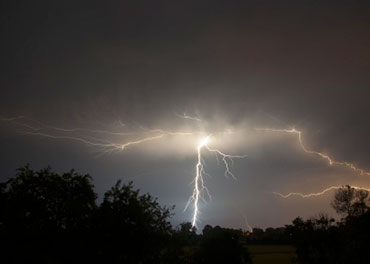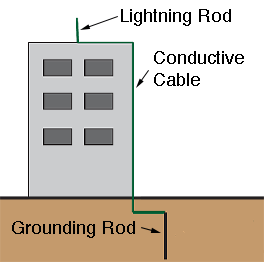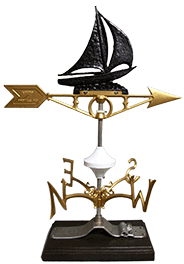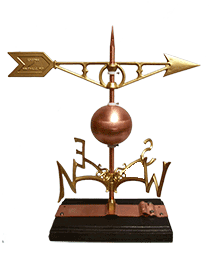What is Lightning?

Lightning is a giant discharge of electricity accompanied by a brilliant flash of light and a loud crack of thunder. The spark of the lightning bolt can reach over five miles and raise the temperature of the air by as much as 50,000 degrees Farenheit.
Scientists believe that ice particles collide as they swirl inside the clouds around during a storm, causing a separation of electrical charges. Positively charged ice crystals rise to the top of the thunderstorm, and negatively charged ice particles and hailstones drop to the lower parts of the storm. Enormous charge differences develop.
A moving thunderstorm also gathers positively charged particles along the ground that travel with the storm. As the differences in charges continue to increase, positively charged particles rise up tall objects such as trees, houses, and telephone poles as well as people.

The negatively charged bottom part of the storm sends out an invisible charge toward the ground. When the charge gets close to the ground, it is attracted by all the positively charged objects, and a channel develops. The subsequent electrical transfer in the channel is lightning.
As buildings become taller, lightning becomes more of a threat. Lightning can damage structures made of most materials (masonry, wood, concrete and steel) as the huge currents involved can heat materials to high temperature, causing a potential for fire.
Despite the adage, lightning frequently strikes twice. Tall buildings can receive dozens or even hundreds of lightning strikes over the course of a year, with multiple strikes possible during single storms. Without a lightning rod, each of these strikes could cause damage, electrocution or fires. Modern skyscrapers depend on lightning rods. Lower buildings and private homes also benefit from lightning rods, especially if the roof of the structure is the highest point in the surrounding area. With fire a likely result of even a single lightning strike, a lightning protection system is an effective way to divert the energy away from the structure safely.
Lightning Rods Offer Protection

A lightning protection system neither attracts or repels lighting. It acts as a "facilitator" through which lighting can find ground.
A properly installed lightning protection system is comprised of three basic components as depicted in the illustration to the left.
A lightning rod (sometimes called a "point") or decorative weather vane is mounted on the top most point of the building. The conductor, whether it is a lightning rod or weather vane, is connected to a conductive cable that is routed to the ground. At the ground level, the conductive cable is bonded to a grounding rod.


When lightning strikes the lightning rod or weather vane, the energy travels through the conductive cable to the ground rod where it is absorbed. All three components work in tandem to safely route the electrical energy to the ground for safe absorption.
Pictured to the left are two of the many decorative weather vanes that can be installed by Tri-State Lightning Protection as part of a comprehensive system.

Pictured to the left is a typical lightning rod, or "point", as used on structures.
Aside from the technical aspects of designing a lightning protection system, a major consideration is the overall aesthetics of the system in relation to the structure on which it is to be applied.
Many times, lightning rods can be placed on the structure with no (or minimal) appearance from ground level. Other times, the homeowner will opt for a more "decorative" look with a weather vane.
Tri-State Lightning Protection works closely with building owners, architects and engineers to ensure that the system is effeciently designed and works effectively.
What's Your Risk?
-
While any building can be at risk from the unpredictable nature of a lightning strike, certain factors can put your building at a greater risk:
- Previous lightning damage
- Located in an area that has frequent thunderstorms
- Located in an open area, on a hill, or near a large body of water
- Tall trees that hang over the roof of the structure
- The structure has a metal, brick, or stone chimney
- Has a metal ridge vent or aluminum siding
- Lacks surge protection
